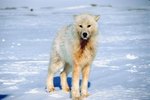
Wolves are gregarious mammals that are part of the family Canidae. They're seen all throughout Asia, North America and in northern portions of Europe. One type even resides in Africa. The wolf universe is made up of three species, which are gray wolves (Canis lupus), red wolves (Canis rufus) and Ethiopian wolves (Canis simensis).
Wolf Reproduction Basics
Female wolves, across the board, are usually pregnant for roughly nine weeks. Their litters are usually made up of anywhere between one and 11 juveniles. Newborn wolves usually tip the scales at approximately 1 pound. Once the little ones are about 9 months old, they're finally mature. Reproduction in wolves occurs once annually.
Wolves and Dens
Female wolves give birth to their offspring inside of dens. Many different things can serve as dens for these canids. Holes in the dirt can function as dens, for one, as can trees that have collapsed to the ground, logs, caverns and even sunken areas in the middle of grass. Wolves often transfer their offspring to new dens when they get a little older and develop more.
Pack Life
As social creatures, wolves reside within social units that consist of their relatives. These are known as "packs." Mature mother and father wolves -- or "alphas" -- are in charge of these packs. The rest of the members of the packs are usually their children, but it isn't unheard of for other non-family wolves to enter packs, too. Packs typically have between eight and nine individuals, although some can be markedly larger. Some wolf packs have of as many as between 20 and 30 specimens.
Monogamy in Wolves
Wolves are generally monogamous animals. When female and male wolves pair up, it often is a lifetime partnership. When they reproduce, they typically work as teams in looking after their babies. While exclusively alpha wolves reproduce, all members of wolf packs cooperate in nurturing juveniles. Alpha mothers nurse their pups, but they also receive help from other female pack members -- those of lower social status. Wolves in packs all participate in duties such as watching the pups when the alphas aren't around, too. They even take on tasks such as delivering meals to the alpha mothers and their pups. Young wolves typically remain alongside their parents until they're a maximum of 2 years in age.
Communication in Wolves
A major component of the family lives of wolves is vocalization. They employ a handful of elaborate sounds as a means of sending messages to each other. Youthful wolves receive their education in communication from their packs as a whole. Not only do they "talk" to each other through sounds, they also do so via touch and physical hints. Howling and crying are both typical forms of vocalization in wolves.
References
- Smithsonian National Museum of Natural History: Canis Lupus
- University of Michigan Animal Diversity Web: Canis Lupus
- University of Michigan Animal Diversity Web: Canis Rufus
- The IUCN Red List of Threatened Species: Canis Lupus
- The IUCN Red List of Threatened Species: Canis Rufus
- NatureWorks: Canis Rufus
- Animal Planet: Wolf
- San Diego Zoo Animals: Wolf
- University of Michigan Animal Diversity Web: Canis Simensis
- PBS Nature: What Females Want
Resources
Photo Credits
-
Jupiterimages/Photos.com/Getty Images




